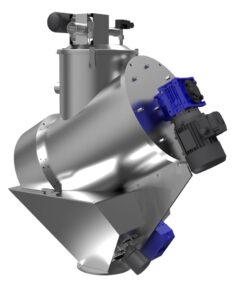MixeReceiver is a new patent-protected device incorporating both the mixing and loading processes. Unifying both delivers a compact, easy-to-use & cost-effective device.
Feeding a batch of raw materials mandates a loading process that causes separation due to differences in bulk density. Therefore, to receive a homogenous mixture, it’s recommended to use a mixer that is situated beneath the vacuum receiver.
When the vacuum receiver is installed above the mixer, the established height of the system is thus increased, requiring advanced planning, support, consideration for operational safety, and a cumbersome, ineffective process for cleaning and maintenance.

The bottom of the mixer houses a container that holds materials once mixing is completed. After emptying the mixer, its flap closes, and a new loading process begins. As soon as the rotating sensor at the bottom of the container (7) recognizes a decrease of the mixture level, the controller ensures that the mixer is emptied and initiates a new loading and mixing process. The cycle starts with the closure of the bottom flap (6) using a piston (5) that seals the MixeReceiver. Following this process, the vacuum valve (1) opens, allowing for the vacuum to occur to enable a new batch to be ingested into the container. At the end of the loading process, the vacuum valve is shut, ending the loading process, and mixing the batch commences. After the mixing process, the unit waits for a signal from the sensor, the door of the MixeReceiver is opened (6) and the batch empties downwards. The mixer is inclined, allowing the batch to pour out once mixing is complete. The door remains open until the container fully empties itself.

Momentum is gaining for working with regrinding and recycled materials. As such, by combining a proportional valve in the device’s opening, it is possible to control the composition of the loading process.
Converse directamente con nuestros especialistas y encuentre formas de ahorrar en costos, inventario y tiempo.
Calcule su Ahorro